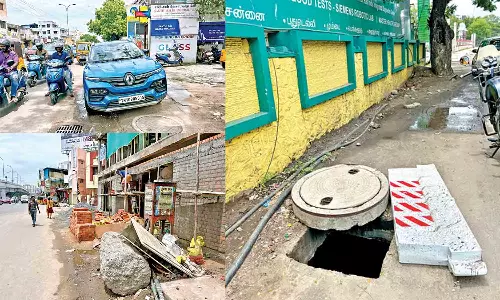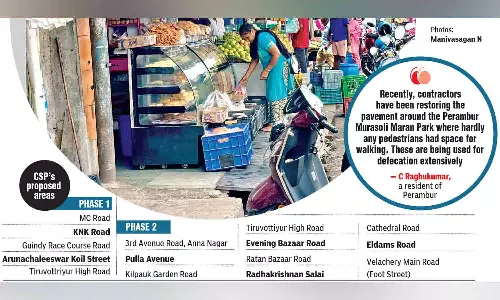Chennai's footpath crisis: Missing pavements put pedestrians in peril
Footpaths in the city are often encroached by roadside eateries, retail shops, illegal parking, etc., While the Corporation has been taking several measures to address the problem, there are barely any walkable footpaths, fume residents and activists.;
CHENNAI: In their most basic function, footpaths provide a safe way to walk without the fear of getting into accidents. With the State government’s focus on building Smart Cities, urban planners, and engineers are beginning to understand the relevance and significance of providing a safe and pollution-free space for pedestrians.
However, Chennai as a capital city is hardly a pioneer in achieving that goal. A study titled ‘Road Accidents Reports (2019-2022)’ by Tamil Nadu State Transport Corporation (TNSTC) revealed that the proportion of pedestrian fatalities has increased from 11% in 2019 to 43% in 2022.
That’s a substantially worrisome spike in 3 years, especially considering that the Greater Chennai Corporation (GCC) has been focusing on renovating and relaying footpaths that have been for over a decade.
Encroachments
Footpaths in the city are almost non-existent, as most of them are illegally used for parking, and also encroached upon by retail outlets, street vendors and pushcart eateries. This leaves less than 5% of the pavements being utilized by the public.
One of the main reasons for vanishing footpaths is the Corporation’s negligence, rued denizens and activists, who accuse the government departments of digging up well-laid footpaths often.
“Every now and then, either the civic body or Tangedco digs up a footpath for maintenance work of underground cable or storm water drains, and, fail to replace the broken seal doors and pavements after they’re done,” lamented T Ajitha, a resident of Kaladipet in Tiruvottiyur. “It has been over 8 years since the GCC took measures to address such issues in the city. It’s one of the most neglected civic problems.”
Additionally, the number of roadside eateries has increased in the evening hours. This has worsened the situation, as the public is forced to walk on the main roads. “The Corporation authorities are aware of such illegal eateries. For instance, footpaths along the Marina beach are filled with two-wheelers. The local body constructed a footpath in MC Road but later it was encroached by street vendors,” another resident stated.
Encroachments on footpaths and lack of maintenance have been a perennial civic issue in the city. “The mobile eatery shops open only after 6 pm,” said R Ramesh, a resident and a civic activist in north Chennai. “You can find them on the footpath along the Theagaraya Metro Station. Political banners, tiffin shops, and other encroachments are also a problem. Why can’t the authorities remove them whenever they pop up?”
Similarly, in Mylapore, the Mada Veedhi’s pavement was constructed for free movement of temple devotees under the Singara Chennai project. Now, it’s occupied by fruit and vegetable vendors. “Yearly encroachment drives are all bogus and eyewash. Those pavements have not been used by the public in years,” he added. “What’s worse is that the shops dump waste into the existing storm water drains (SWDs) through the manhole on the footpaths. This blocks the drains, which results in inundation during intense spells. Even the local politicians give the footpath space for rent to these eatery shops.”
Missing in residential areas
Footpaths in residential localities are also not spared. Many are covered by street parking or construction of ramps over the SWDs.
Residential buildings, especially gated communities, use the pavements as ramps for cars and two-wheelers. Provision of concrete or granite bollards on pavements that prevent parking has not helped. Additionally, footpaths are not disabled-friendly either.
“Recently, contractors have been restoring the pavement around the Perambur Murasoli Maran Park where hardly any pedestrians had space for walking. These are being used for defecation extensively by the residents living in the nearby housing boards. Also, footpaths made of concrete blocks have not been fixed properly; those have sunk in several locations after the recent rains,” pointed out C Raghukumar, a resident of Perambur.
The manhole-covers atop the SWDs are of bad quality that do not sustain even for a month. The public urged the GCC to hand over maintenance to a contractor who follows the proper guidelines. Also, a hefty penalty should be imposed on those who fail to fix damaged footpaths.
“Lack of coordination between the various agencies has always been a matter of concern. They must be a mechanism where the various agencies can work in tandem and provide proper ducts or pipes well in advance and avoid the road cuts,” he opined.
ITDP’s measures
Following multiple complaints and surveys, the Institute for Transportation and Development Policy (ITDP) is working along with GCC on the ‘Complete Street Project (CSP)’ that aims to transform streets and footpaths from north to south Chennai into a more economical and climate-resilient infrastructure.
The CSP focuses on integrated planning, and creates design-resilient utilities (both under and above ground) to manage floods, make streets cut-proof, include landscaping elements, and ensure 30 years of life-span for the streets. From 2014-2020, over 170 km of streets were redeveloped in bus-route roads with safe and friendly infrastructure.
“The completed footpaths gave access to around 1.24 million Chennaites who live within 300 metres of the completed improvements,” said Venugopal AV, program manager, Healthy Streets and Partnerships, ITDP. That’s why 6 neighbourhoods have been chosen to provide equitable growth prospects.
“Tondiarpet, Anna Nagar, Nungambakkam, Mylapore, Adyar and Velachery have been identified after examining factors like footfall, street character and streets that urgently need development,” he added.
After the footpath renovation project is completed in the city, it would benefit both the general public and retailers. For instance, a ITDP study revealed that sales in retail shops in Pondy Bazaar increased by 15-20% after the renovation was completed.
What GCC says
A senior official with the GCC stated that footpaths in 40 roads including Egmore, Purasawalkam, and New Avadi Road would get a new facelift, for which Rs 35 crore was allocated tentatively.
“Through this project, the focus is on continuity that connects areas through the footpath. Parks, hospitals, and other public facilities will also be connected as part of a safe- walking and cycling network. Each year, the civic body spends around Rs 10 crore to renovate and repair footpaths in the city, and also complete patch works regularly,” explained the official.
If contractors decide to dig up these renovated or newly-laid footpaths – either for SWD repair or underground maintenance of any kind, he added: “They will have to pay the Corporation double the charges to fix it. Zonal officials have given assurances that eviction drives and inspections are being done regularly.”
What is the ‘Complete Street Project’?
• The CSP aims to improve accessibility to 42 Metro stations, 21 railway stations and 911 bus stops in Tondiarpet, Anna Nagar, Nungambakkam, Mylapore, Adyar and Velachery
• At least 19 out of 40 stations in phase one Metro area will be covered
• It would improve accessibility to 610 schools and 174 anganwadis and serve 220 EWS settlements
• Under phase 1, at least 4.95 km of streets under various stages of implementation, and 6.65 km under discussion to initiate implementation in 2024-2025
• Additional street networks across potentially two neighbourhoods are under discussion
• Basic functional footpaths not including/including minimal utilities to be taken up in networks along bus route roads where SWD works are completed and no Metro works are going on. Potential streets have been identified and are in discussion towards next steps
• All SWD projects under construction will be finished ensuring that it serves as a good footpath
• It will also be ensured that all upgraded or newly-laid out carriageway works will be completed with the provision of safe, continuous and comfortable pedestrian infrastructure as per IRC guidelines



